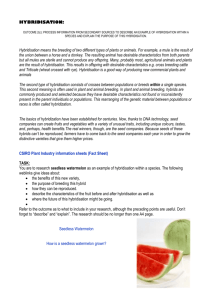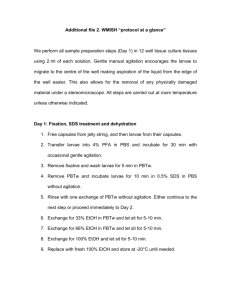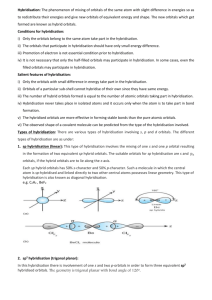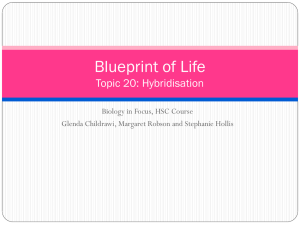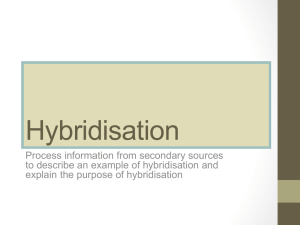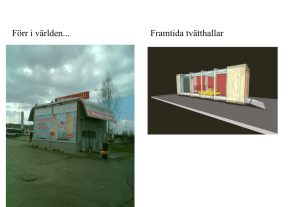Protocol
advertisement
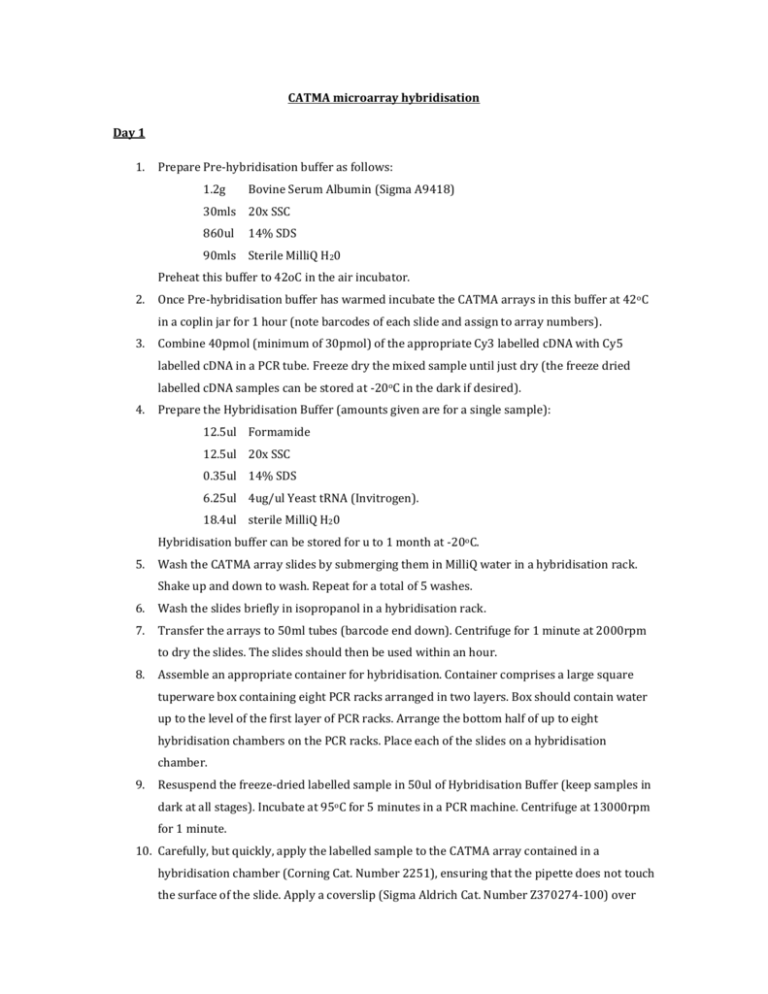
CATMA microarray hybridisation Day 1 1. Prepare Pre-hybridisation buffer as follows: 1.2g Bovine Serum Albumin (Sigma A9418) 30mls 20x SSC 860ul 14% SDS 90mls Sterile MilliQ H20 Preheat this buffer to 42oC in the air incubator. 2. Once Pre-hybridisation buffer has warmed incubate the CATMA arrays in this buffer at 42 oC in a coplin jar for 1 hour (note barcodes of each slide and assign to array numbers). 3. Combine 40pmol (minimum of 30pmol) of the appropriate Cy3 labelled cDNA with Cy5 labelled cDNA in a PCR tube. Freeze dry the mixed sample until just dry (the freeze dried labelled cDNA samples can be stored at -20oC in the dark if desired). 4. Prepare the Hybridisation Buffer (amounts given are for a single sample): 12.5ul Formamide 12.5ul 20x SSC 0.35ul 14% SDS 6.25ul 4ug/ul Yeast tRNA (Invitrogen). 18.4ul sterile MilliQ H20 Hybridisation buffer can be stored for u to 1 month at -20oC. 5. Wash the CATMA array slides by submerging them in MilliQ water in a hybridisation rack. Shake up and down to wash. Repeat for a total of 5 washes. 6. Wash the slides briefly in isopropanol in a hybridisation rack. 7. Transfer the arrays to 50ml tubes (barcode end down). Centrifuge for 1 minute at 2000rpm to dry the slides. The slides should then be used within an hour. 8. Assemble an appropriate container for hybridisation. Container comprises a large square tuperware box containing eight PCR racks arranged in two layers. Box should contain water up to the level of the first layer of PCR racks. Arrange the bottom half of up to eight hybridisation chambers on the PCR racks. Place each of the slides on a hybridisation chamber. 9. Resuspend the freeze-dried labelled sample in 50ul of Hybridisation Buffer (keep samples in dark at all stages). Incubate at 95oC for 5 minutes in a PCR machine. Centrifuge at 13000rpm for 1 minute. 10. Carefully, but quickly, apply the labelled sample to the CATMA array contained in a hybridisation chamber (Corning Cat. Number 2251), ensuring that the pipette does not touch the surface of the slide. Apply a coverslip (Sigma Aldrich Cat. Number Z370274-100) over the slide allowing the labelled sample to spread across the surface of the array. Try to remove any air bubbles. Place the cover of the hybridisation chamber over the top of the slide. Lay a double layer of tissue over the hybridisation chambers making sure the edges and placed in the water. Close the lid of the hybridisation container. 11. Incubate at 42oC overnight (16-20 hours) in the dark in an air incubator. 12. Prepare Wash Solution 1 (250mls): 25mls 20x SSC 1.8ml 14% SDS 223mls Sterile MilliQ H2O Preheat to 42oC overnight. Day 2 13. The following day prepare: Wash Solution 2 (250ml): 1.25mls 20x SSC 1.8mls 14% SDS 247mls Sterile MilliQ H2O Wash Solution 3 (1000mls): 5mls 20x SSC 995mls Sterile MilliQ H2O. 14. Remove the arrays from the hybridisation chamber. Carefully remove the coverslip by immersing is wash solution 1 (preheated to 42oC) until the part freely. 15. Incubate the arrays in wash solution 1 (preheated to 42oC) in a hybridisation rack for 5 minutes with shaking on an orbital shaker. 16. Incubate the arrays in wash solution 2 in a hybridisation rack for 10 minutes with shaking. 17. Incubate the arrays in wash solution 3 in a hybridisation rack for 1 minutes with shaking. Repeat for a total for 4 washes. 18. Briefly immerse the arrays in isopropanol in a hybridisation rack. 19. Transfer the arrays to 50ml tubes (barcode end down). Centrifuge for 1 minute at 2000rpm to dry the slides. 20. Store the slides in the dark.
